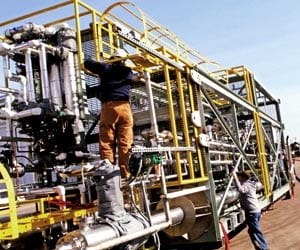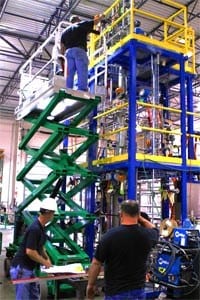Designing chemical distillation towers is done in detailed stages. Starting with step one, the model, is the time to decide how the chemical mixtures are going to be separated. The additional number stages of a distillation tower is dependent on: chemical properties such as vapor pressure, evaporation point, the mixture properties of the substances being separated and the desired purity of the end distillate. Based on the properties of these chemicals, the lighter molecules rise and heavier ones fall, each continuing through the distillation tower stages, gradually separating. With components such as hefty differences in boiling points or high individual component volatility, less stages would be necessary. Here is a nifty infographic that will give you a visual understanding of the design process for any distillation system.

Distillation towers are complicated beasts, but can be simplified with a full understanding of the elements that make up the separation process and the formulas needed to successfully design all distillation towers. These different elements include:
- Flood Ratio – the measurement of the accumulation of liquid in the column. Tray spacing, placement and hole size effect the flood ratio. This ratio is consisted of two main components:
- Jet flood – has the limit of 100% and 85% design for new trays or packing
- Downcomer flood – 100% limit, best practices are to design for 85% for new trays, only concern for columns with trays.
- Weeping points/turndown – the point at which liquid begins to fall through perforations in the trays.
- Less than 50% is acceptable, point of 100% is called the “dump point”, vapor pressure must be set at a level that balances foam build up with liquid leaking through plate holes
- Fs Vapor – ratio used with the gmp/FT2 ratio preliminary column sizing. The proper formula is Fs=Us*SQRT(Rhov)
- Fs = Vapor F Factor
- Us = Vapor superficial velocity, ft/s
- GPM/ FT2 LIQUID – ratio used for preliminary equipment sizing to determine column are requirements. For this formula, the liquid gallons per minute (gpm) are divided by the column area
- gmp/ft2 = (liquid gpm)/(column area)
- gpm – gallon/minute
- Area – ft2
Based on an already proven technology, EPIC is the distillation expert that physically designs and manufactures distillation towers. There are a few things that help any process engineer with the development of any distillation tower project:
Process Systems Factors
- Heating and cooling mediums that are wanted
- Desired operation temperature range during heating, separation and cooling
- The operating pressure range during the heating, separation and cooling stages
- Recycle/Waste Stream Properties
- The acceptable composition
- The need to know of additional processing requirements
- Propertied of Distillation Feed
- Composition – is the material solid, non-condensable, azeotypes
- Feed rate and temperature
- Output Requirements
- Desired end products specifications
- Chemical composition
- Purity requirements
As mentioned, distillation towers are complicated beasts, so it is best to put your process technology in the right hands. Here is a look at a Pilot Scale System with Industrial Distillation Equipment Achieves 90% CO2 Sequestration. EPIC also completed a distillation project that focused on being a continuous operation, which you can read more about here.
Contact and EPIC engineer to discuss any distillation questions you may have or get your started on the FEE stage of a distillation project.
